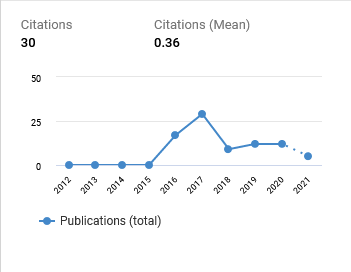Sustainable Urban Development and Social Sustainability in the Urban Context
DOI:
https://doi.org/10.29080/eija.v2i1.15Keywords:
Sustainable development, urban planning, social sustainability, communityAbstract
Social sustainability and sustainable urban developments are major challenges across the world both developed and developing countries. In general there is a conflict between the approach of sustainable development and social sustainability in the urban context. The concept of sustainability brings a key framework for extensive literature on urban design, architecture and planning. Nevertheless there is a considerable overlap between the social dimensions of sustainability and the theories or notions, for instance the ‘sustainable societies’ that are highlighted in the midst of other aspects: social equity and justice. Such society is widely expected to offer a situation for long-term social relations and activities which are sustainable, inclusive and equitable in a wider perception of the term (environmentally, socially and economically). The method adopted to address this aim involves a content analysis of available academic literature, with focus on the planning sustainable development, built environment, social sustainability, and urban planning fields. The findings demonstrate that in spite of some opposing evidence, many studies have confirmed that there has been displacement of the debate on the term of ‘sustainability’ from ‘ecological and environmental aspects into social and economic aspects’. It is related to how the community feel safe and comfortable living in their own communities, how have they felt of proud of the place where they live. The aim of the paper is to improve our understanding of current theories and practices of planning sustainable development and discuss whether the approach of sustainable development aligns with social sustainability objectives.
Downloads
References
Almahmoud, E & Doloi, HK 2015, 'Assessment of social sustainability in construction projects using social network analysis', Facilities, vol. 33, no. 3/4, pp. 152-152.
Bellair, PE 1997, ‘Social interaction and community crime: examining the importance of neighbour networks’, Criminology, vol. 35, no. 4, pp. 677-704.
Berry, M 2006, Housing affordability and the economy: A review of macroeconomic impacts and policy issues, Australian Housing and Urban Research Institute.
Bramley, G, & Power, S 2009, ‘Urban form and social sustainability: the role of density and housing type’, Environment and Planning B Planning and Design, vol. 36, pp. 30-48.
Bramley, G, Dempsey, N, Power, S, Brown, C & Watkins, D 2009, ‘Social sustainability and urban form: evidence from five British cities’, Environment and Planning A, vol. 41, no. 9, pp. 2125-2142.
Burke, T, Pinnegar, S, Phibbs, P, Neske, C, Gabriel, M, Ralston, L & Ruming, K 2007, Experiencing the housing affordability problem: blocked aspirations, trade-offs and financial hardships, Australian Housing and Urban Research Institute.
Calder, M & Beckie, M 2013, ‘Community engagement and transformation: case studies in municipal sustainability planning from Alberta, Canada’, Community Development, vol. 44, no. 2, pp. 147-160.
Chan, E, & Lee, G 2008, ‘Critical factors for improving social sustainability of urban renewal projects’, Social Indicators Research, vol. 85, no.2, pp. 243-256.
Colantonio, A & Dixon, T 2010, Urban Regeneration and Social Sustainability Best Practice from European Cities, Wiley, Chicester.
Davidson, K, Kellett, J, Wilson, L, & Pullen, S 2012, ‘Assessing urban sustainability from a social democratic perspective: a thematic approach’, Local Environment, vol. 17, no. 1, pp. 57-73.
Dempsey, N 2008, ‘Does quality of the built environment affect social cohesion?’,Proceedings of the ICE-Urban Design and Planning, vol. 161, no. 3, pp. 105-114.
Dempsey, N, Bramley, G, Power, S, & Brown, C 2011, ‘The social dimension of sustainable development: defining urban social sustainability’,
Sustainable Development, vol. 19, no. 5, pp. 289-300.
Dillard, J, Dujon, V, & King, MC (Eds) 2008, Understanding the social dimension of sustainability, Routledge.
Ghahramanpouri, A, Lamit, H & Sedaghatnia, S 2013, 'Urban social sustainability trends in research literature', Asian Social Science, vol. 9, no. 4, pp. 185-193.
Hamiduddin, I 2015, 'Social sustainability, residential design and demographic balance: neighbourhood planning strategies in Freiburg, Germany', The Town Planning Review, vol. 86, no. 1, pp. 29-52.
House, JS, Robbins, C, & Metzner, HL 1982, ‘The association of social relationships and activities with mortality: prospective evidence from the Tecumseh Community Health Study’, American Journal of Epidemiology, vol. 116, no. 1, pp. 123-140.
Kemp-Benedict, E, Bharwani, S & Fischer, M 2010, ‘Methods for linking social and physical analysis for sustainability planning’, Ecology and Society, vol. 15, no. 3, pp. 4-4.
Lloyd-Sherlock, P 2000, Old Age and Poverty in Developing Countries: New Policy Challenges, World Development, Vol. 28, no. 12, pp. 2157-2168.
Magis, K 2010, ‘Community resilience: an indicator of social sustainability’, Society and Natural Resources, vol. 23, no. 5, pp. 401-416.
Manzi, T 2010, Social sustainability in urban areas communities, connectivity and the urban fabric, Earthscan, London ; Washington, DC.
Manzo, LC, & Perkins, DD 2006, ‘Finding common ground: the importance of place attachment to community participation and planning’, Journal of Planning Literature, vol. 20, no. 4, pp. 335-350.
Marinetto, M 2003, ‘Who wants to be an active citizen? the politics and practice of community involvement’, Sociology, vol. 37, no. 1, pp. 103-120.
McMillan, DW & Chavis, DM 1986, ‘Sense of community: a definition and theory’, Journal of Community Psychology, vol. 14, no. 1, pp. 6-23.
McKenzie, S 2004, Social sustainability: towards some definitions, Magill: Hawke Research Institute, University of South Australia.
Nurul, W 2015, 'Compact urban form for sociability in urban neighbourhoods', International Journal of Social Science and Humanity, vol. 5, no. 10, pp. 822-826.
Office of the Deputy Prime Minister (ODPM) 2006, UK Presidency: EU ministerial informal on sustainable community’s policy papers, ODPM: London.
Preston, J, & Rajé, F 2007, ‘Accessibility, mobility and transport-related social exclusion’, Journal of Transport Geography, vol. 15, no. 3, pp. 151-160.
Selman, P 2001, ‘Social capital, sustainability and environmental planning’, Planning Theory & Practice, vol. 2, no. 1, pp. 13-30.
Talen, E 1999, ‘Sense of community and neighbourhood form: an assessment of the social doctrine of new urbanism’, Urban Studies, vol. 36, no. 8, pp. 1361-1379.
Thompson, S & Kent, J 2014, 'Connecting and strengthening communities in places for health and well-being', Australian Planner, vol. 51, no. 3, pp. 260-271.
United Nations Population Fund 2007, State of world population 2007: unleashing the potential of urban growth, UNFPA: New York.
Uzzell, D, Pol, E, & Badenas, D 2002, ‘Place identification, social cohesion, and enviornmental sustainability, Environment and Behavior, vol. 34, no. 1, pp. 26-53.
Valdes-Vasquez, R & Klotz, LE 2013, ‘Social sustainability considerations during planning and design: framework of processes for construction projects’, Journal of Construction Engineering and Management, vol. 139, no. 1, pp. 80-89.
Vallance, S, Perkins, HC & Dixon, JE 2011, ‘What is social sustainability? a clarification of concepts’, Geoforum, vol. 42, no. 3, pp. 342-348.
Walljasper, J, Fried, B & Photographer, PF 2007, The great neighbourhood book placemaking, New Society Publishers, Limited Consortium Book Sales & Distribution, Gabriola Island, Minneapolis.
WCED (World Commission on Environment and Development) (1987) Our Common Future, Oxford: Oxford University Press.
Wendell, C 2005, International Housing Affordability.
Wheeler, S 2004, Planning for sustainability: creating livable, equitable, and ecological communities, Routledge, New York, NY.
Whitehead, C, 2006, Planning Policies and Affordable Housing: England as a Successful Case Study?, Housing Studies, Vol. 22 (1) pp. 25-44.
Williams, K, Jenks, M, & Burton, E (Eds.) 2000, Achieving sustainable urban form, Taylor & Francis, London.
Winston, C 2000, ‘Government failure in urban transportation, Fiscal Studies, vol. 21, no. 4, pp. 403-425.
Woodcraft, S 2012, ‘Social sustainability and new communities: moving from concept to practice in the UK’, Procedia - Social and Behavioral Sciences, vol. 68, pp. 29-42.
Yates, J & Gabriel, M 2006, National Research Venture 3: Housing Affordability for Lower Income Australians, Australian Housing and Urban Research Institute.
Yates, J, Kendig, H, Phillips, B, Milligan, V & Tanton, R, 2008, Sustaining fair shares: the Australian housing system and intergenerational sustainability, Australian Housing and Urban Research Institute.
Yates, J, Milligan, V, Berry, M, Burke, T, Gabriel, M, Phibbs, P, Pinnegar, S &
Randolph, B, 2007, Housing affordability: a21st century problem, Australian Housing and Urban Research Institute.
Yiftachel, O & Hedgcock, D 1993, ‘Urban social sustainability - the planning of an Australian city’, Cities, vol. 10, no. 2, pp. 139-157.Choguill (1996) Toward Sustainability of Human Settlements, Habitat International, Vol. 20 No 2, Elsevier Science Ltd, UK: v-viii.

Downloads
Published
How to Cite
Issue
Section
Categories
License
- Authors retain copyright and grant the journal right of first publication with the work simultaneously licensed under a Creative Commons Attribution ShareAlike License that allows others to share the work with an acknowledgment of the work's authorship and initial publication in this journal.
- Authors are able to enter into separate, additional contractual arrangements for the non-exclusive distribution of the journal's published version of the work (e.g., post it to an institutional repository or publish it in a book), with an acknowledgment of its initial publication in this journal.
- Authors are permitted and encouraged to post their work online (e.g., in institutional repositories, pre-print sites, or on their website) prior to and during the submission process, as it can lead to productive exchanges, as well as earlier and greater dissemination of published work.
































